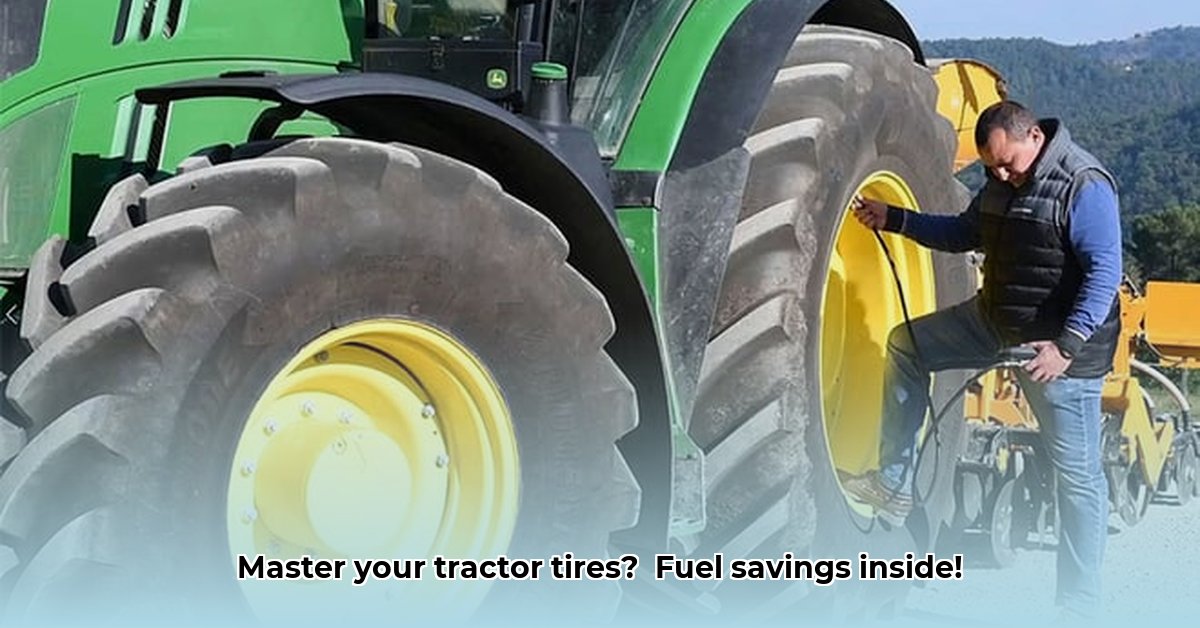
Rear Tractor Tire Pressure: Maximize Your Tractor's Performance and Protect Your Soil
Maintaining the correct rear tractor tire pressure is a simple yet crucial aspect of tractor maintenance. Proper inflation significantly impacts fuel efficiency, tire longevity, and soil health. This guide provides a step-by-step process for checking, adjusting, and maintaining optimal tire pressure, ensuring your tractor operates at peak performance. Ignoring this seemingly simple task can lead to costly repairs and reduced yields. Did you know that under-inflated tires can decrease fuel efficiency by as much as 20%? For more on tire sizing, see this helpful guide: Tire Sizing Explained.
Checking Your Tire Pressure: A Quick and Easy Process
Before adjusting tire pressure, you need an accurate reading. Use a heavy-duty tire pressure gauge (a standard car gauge may not be sufficient for larger agricultural tires). Here's how:
- Clean the Valve Stem: Remove any dirt or debris from the valve stem using a clean cloth. Contamination can lead to inaccurate readings.
- Attach the Gauge: Securely attach the pressure gauge to the valve stem. Ensure a tight seal.
- Record the Pressure: Note the reading displayed on the gauge and record it for each tire. Don't assume all tires will have the same pressure.
- Repeat for All Tires: Repeat steps 1-3 for each rear tire on your tractor.
Finding the Ideal Pressure: Consult Your Owner's Manual
Your tractor's owner's manual provides the recommended tire pressure for your specific model and tire size. This information is usually found in the tire specifications or maintenance sections. If you can't locate it, contact your tractor's manufacturer or a local farm equipment dealer. Remember, the recommended pressure is a starting point. Factors like load and terrain may require slight adjustments.
Adjusting Tire Pressure: A Safe and Efficient Procedure
Once you know the recommended pressure and your current readings, adjust accordingly using a high-capacity air compressor (a standard car compressor is often inadequate).
- Connect the Compressor: Securely attach the air compressor to the valve stem.
- Add Air Gradually: Add air slowly, frequently checking the pressure with your gauge to avoid over-inflation.
- Reach the Target Pressure: Stop adding air when you reach the recommended pressure for the tire.
- Verify Pressure: Double-check all tires to ensure they are properly inflated.
The Impact of Incorrect Tire Pressure: Avoid These Costly Mistakes
Incorrect tire pressure significantly affects your tractor's performance and soil health.
- Under-inflation: Leads to increased fuel consumption, premature tire wear, and soil compaction. This can reduce crop yields and damage soil structure.
- Over-inflation: Causes a rougher ride, uneven tire wear, and increased risk of tire failure. It can also damage the tire itself.
Establishing a Routine: Regular Tire Pressure Checks
Regular tire pressure checks are essential for optimal tractor performance and longevity. Make it a part of your pre-operation routine. This simple task can prevent breakdowns, improve fuel efficiency, and protect your investment and soil. Dr. Emily Carter, Agricultural Engineer at Purdue University, states, "Regular tire pressure checks are a cost-effective preventative maintenance practice that significantly impacts both operational efficiency and long-term soil health."
Key Takeaways:
- Proper tire pressure is crucial for fuel efficiency, tire life, and soil health.
- Always consult your owner's manual for recommended tire pressures.
- Regular tire pressure checks are essential for preventing costly repairs and maximizing tractor performance.
- Use a heavy-duty air compressor and pressure gauge for agricultural tires.
Regular tire pressure checks are a simple yet effective way to ensure your tractor's optimal performance and contribute to sustainable farming practices. Don't overlook this crucial maintenance task!